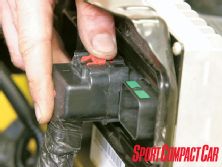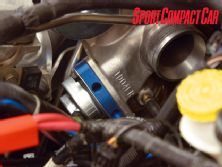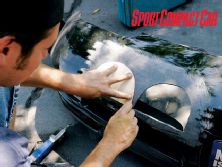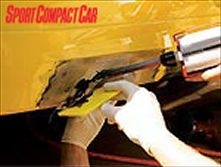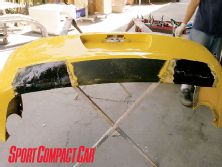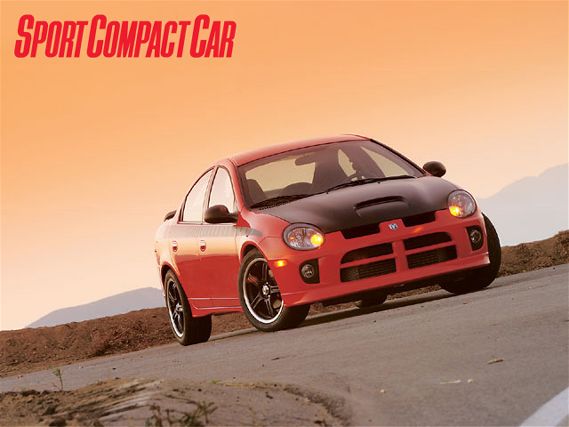 | Project Dodge SRT-4 - Tech Project
| Project Dodge SRT-4 - Tech Project
Nineteen sixty-four Pontiac GTO, 1962 Chevy Impala SS 409, 1969 Chevy Camaro, 1970 Plymouth AAR Cuda, 2003 Dodge SRT-4-musclecars, every one.
Dodge reinvented the classic formula for performance last year when it crammed a huge engine in a small body and created the SRT-4-the baddest, boosted, burnout machine to be had under 20 large. It handily won our Tough Crowd comparison test (January 2003) with its combination of huge power, admirable handling and stop-right-now brakes, and when the contest was over, we knew we had to have one.
Then we figured if we were going to be driving around in the modern incarnation of a classic musclecar, it might as well look the part. Enter Santini Paint and Body in Westminster, Calif., known to street rod and musclecar goofs across So.Cal. as the place to find flames for their Mustang or pinstripes for their GTO. Turns out, Pete Santini does a pretty good job turning the Neon's modern soap bar styling into a tribute to the 1970 Plymouth AAR Cuda. Santini and the vinyl artists at Permanent Impressions in Huntington Beach, Calif., are responsible for our little homage to Dan Gurney's '70s repli-racer.
For those of you born after Elvis got really fat and really dead, the AAR Cuda was a production-car version of the Cuda Dan Gurney and his All-American Racer team raced in the SCCA Trans Am series. Built to compete with the Z28 Camaro and Boss 302 Mustang on the street and on the track, the AAR Cuda and its basic twin, the Dodge Challenger T/A, were built and sold only one year, 1970. They each had a unique look that included a black hood with hoodscoop, multiple spoilers, side exhaust and striping. And both were the only Mopars ever powered by the 340 cubic inch Six Pack engine-which means it had three two-barrel carburetors. In 1970, the AAR Cuda was as close to a Trans Am racer as you could get without actually being Dan Gurney.
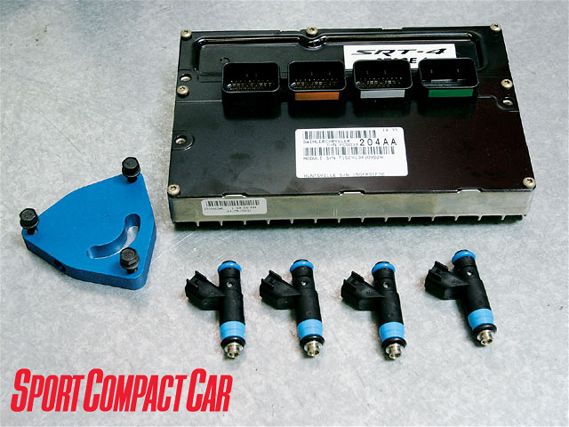 | Stage One doesn't include the blow-off valve spacer (on the left), but we installed it at the same time. It does include a remapped ECU and four 577 cc/min. fuel injectors.
| Stage One doesn't include the blow-off valve spacer (on the left), but we installed it at the same time. It does include a remapped ECU and four 577 cc/min. fuel injectors.
The SRT-4's newfound styling sets the direction for this project: Fast and cheap. The SRT-4 will follow a straightforward upgrade path made available through Mopar. Divided into three stages of engine mods, Mopar's designs on making the SRT-4 more powerful are easy. Mopar also offers a coil-over kit and a few other gizmos we'll install throughout the project. But the in-house Dodge shop certainly isn't the only company interested in the SRT-4's potential. We'll test multiple wheel and tire packages, as well as at least one aftermarket brake kit.
Mopar Stage One
There are few other places in the aftermarket where you'll find this much power and torque for this little money. The Stage One retail price is $399, but we're told the street price is closer to $330. Mopar rates the Stage One kit at 240 hp and 260 lb-ft of torque. However, as we've already experienced with the SRT-4, these are conservative numbers. With Stage One installed, our car made exactly those numbers at the wheels. The peak torque increase isn't huge; however, there is a 10 lb-ft gain throughout most of the midrange.
Our project car in stock form was slightly stronger than previous SRT-4s we've tested, making 227 hp and 256 lb-ft of torque right out of the box. This dyno test was performed with the car still full of Michigan fuel. All other SRT-4s we've tested have used California's notoriously low-octane fuel.
The Stage One ECU includes several unusual calibration changes. Along with the usual higher boost at partial and wide-open throttle, the calibration geeks at Mopar programmed in a boost hold feature during wide-open throttle shifts. This allows the wastegate duty cycle to remain constant while the clutch is depressed as long as the engine isn't on the rev limiter, maintaining boost into the next gear. Boost is also higher in first gear for harder launches and the deceleration exhaust note is more aggressive.
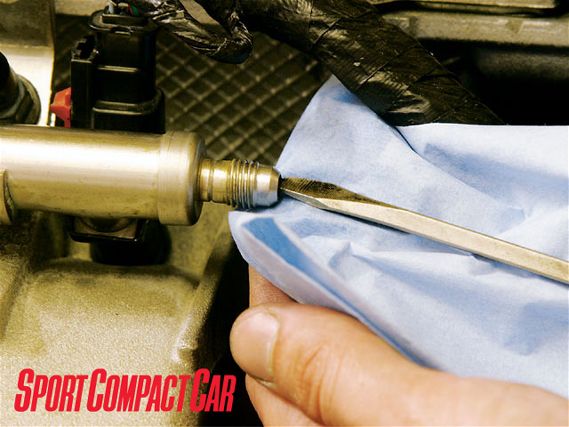 | Dodge installed this convenient valve to purge the fuel system on the end of the fuel rail. Fuel pressure should be bled off here before removing the injectors.
| Dodge installed this convenient valve to purge the fuel system on the end of the fuel rail. Fuel pressure should be bled off here before removing the injectors.
Perhaps the most obvious change in driving the car comes from improved boost response, thanks to a slightly higher overrun of the boost target. This translates to less throttle opening for more boost relative to the stock calibration.
It took only a few hours to install the Stage One kit, which consists of four 577 cc/min. (at 58 psi) fuel injectors and an upgraded ECU. PVO engineers tell us it can be done in half an hour, but we suspect they've done it a few more times than we have. Regardless, it's simple. We also installed the Mopar's blow-off valve spacer, which isn't included with the other Stage One goodies. The spacer turns the stock compressor bypass valve, which reroutes discharged boost back into the turbo, into a blow-off valve that dumps it out into the world. This gives the characteristic purge sound sought after by so many rice boys. We like it. But installing it isn't easy and it added significantly to the install time.
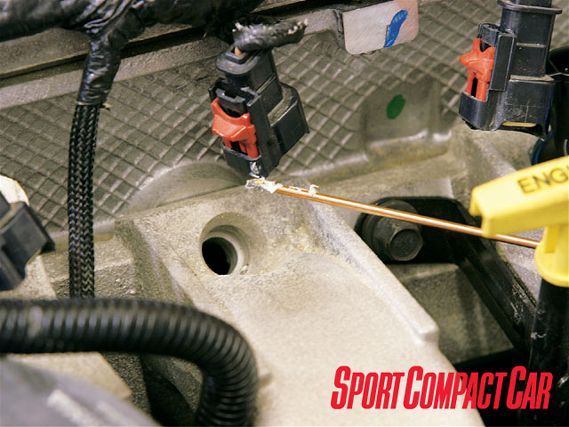 | Removing the debris that builds up around the base of the fuel injectors when they're removed will keep it from being forced into the engine when the new injectors are installed. We performed this operation with a piece of welding rod and some grease.
| Removing the debris that builds up around the base of the fuel injectors when they're removed will keep it from being forced into the engine when the new injectors are installed. We performed this operation with a piece of welding rod and some grease.
The instructions for Stage One installation weren't yet written when we put the kit on our car, but it's simple enough that we managed the job without problems. Still, following the directions in the kit is advisable. After removing the plastic engine cover, the first step is to bleed the pressure in the fuel system through the valve at the end of the fuel rail. We did this with a screwdriver. To remove the rail from the injectors, you must remove the retaining clips, which hold them together.
Be careful when removing and replacing the injectors to not drop anything into the open hole in the intake manifold. We found that the shape of the manifold causes debris to build near the hole, making it easy to push gunk into the engine when installing the new injectors. The instructions, if we had them, would have told us to blow this debris away before removing the injectors. Instead, we removed the debris by fishing around the hole with some grease on the end of a welding rod.
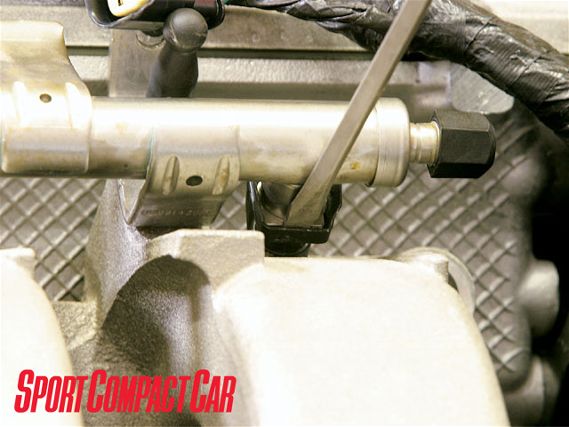 | The clips holding the fuel injectors to the fuel rail must be pried off from below using a screwdriver.
| The clips holding the fuel injectors to the fuel rail must be pried off from below using a screwdriver.
Before removing the ECU, be sure to disconnect the battery. This will ensure that any errant electrons are stopped before they destroy the ECU's sensitive electronics. Swapping ECUs is simple as long as the harness plugs go back in the same location they were in from the factory. That's pretty tough to screw up, but we found ourselves trying to do it at least once. The only other tricky part of this operation is re-installing the ECU with the self-tapping screws that hold it to its mounting bracket. Seeing that the ECU's mounting holes weren't tapped, we stopped to buy a tap. Only later did we find out the fasteners are designed to thread their way through the soft metal of ECU casing without damage. Oh, well.
With the ECU installed, it was a simple matter of reconnecting the battery, building fuel pressure and firing up the engine. If only every mod were this simple.
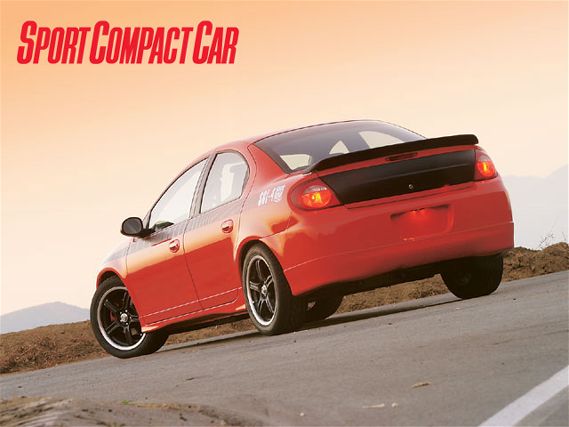 | Project Dodge SRT-4 - Tech Project
| Project Dodge SRT-4 - Tech Project
Appearance
Turning the Neon into an AAR Cuda look-alike is a job we knew we could only leave to professionals. Santini Paint and Body undertook the job with the enthusiasm necessary to turn a Neon into a Cuda. AAR Cudas were available in multiple color options but we knew only Hemi Orange would truly complete the transformation. Santini covered every critical inch on the SRT-4 with the hemi hue, including the underside of the trunklid and inside the door jams.
While they were at it, Santini's crew shaved the antenna and removed the basket handle wing. In its place, we put a small, flat-black lip spoiler just like, well, you know where we get our ideas now.
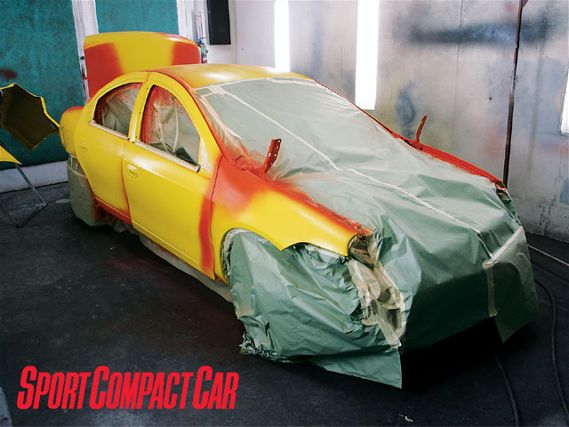 | The moment of truth. SRT-4 becomes AAR Cuda.
| The moment of truth. SRT-4 becomes AAR Cuda.
Finding the old-school lip spoiler wasn't easy, so we asked Extreme Dimensions in Irvine, Calif., to make one for us. The piece in the pictures is actually the solid fiberglass buck that will be used to make the mold for the real deal. In a month or two, Extreme Dimensions will bust out a lightweight, carbon-fiber version. We'll show you more details when we get it.
With an ass only mother Mopar could love, we knew the Neon's bulging backside needed some visual slimming. After much debate, we accomplished this by blacking out the trunk panel between the taillights. This makes it look ever so slightly more like a Cuda, and breaks the orange monotony. While we were back there, we decided to ditch the functionally offensive dual exhaust. News flash: the SRT-4 is a four cylinder. You don't need two pipes for a four cylinder.
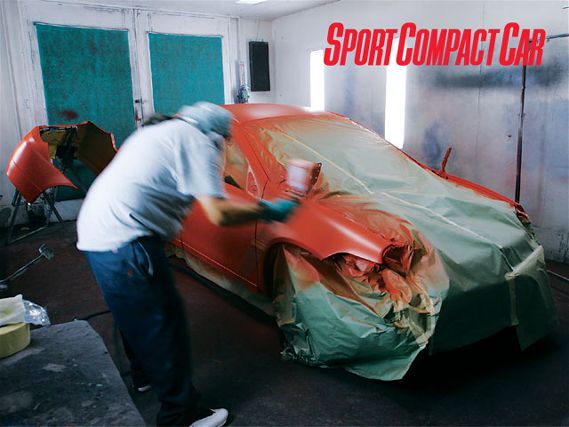 | Project Dodge SRT-4 - Tech Project
| Project Dodge SRT-4 - Tech Project
In our continuing tribute to the AAR Cuda, we decided to fabricate a side-exit exhaust. We haven't actually done that yet, but we did have Santini work some urethane magic on the exhaust cutouts in the bumper. After many hours of cutting and sanding, the dual exhaust outlets vanished.
Completing the AAR theme was left to the vinyl experts at Permanent Impressions. They allowed editor Oldham to hold their hands through a micro-managed vinyl design session that makes the neurosis of autism seem like a mild case of gas. However, this attention to detail produces inarguably striking results. The strobe stripe down the SRT-4's flanks is replicated perfectly, down to the last obsessive line break. And the AAR logo, which adorned the rear quarter panel of the original Cudas, has been gracefully transformed to incorporate the requisite SCC letters. Dan Gurney would be proud.
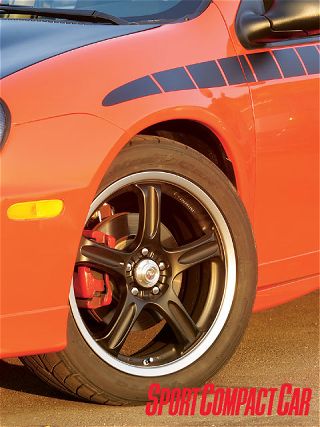 | Project Dodge SRT-4 - Tech Project
| Project Dodge SRT-4 - Tech Project
RH Evolution GT5 wheels sized 17x7 in a 40mm offset were selected for their flat-black finish and polished lip. Dazz Motorsports, importer of Racing Hart wheels claims the GT5 weighs 18 pounds. However, with as much power as the SRT-4 makes, weight was not a primary concern. Plus, the black spokes and machined lip serve our retro look well. OK, technically, the AAR Cuda had silver wheels, but black looks better and you wouldn't have known about the silver if we didn't tell you. The GT5 is also available in 18- and 19-inch sizes and can be had in bronze, gunmetal and silver in addition to flat black.
Nitto NeoGen radials in 225/45ZR-17 were also an appropriate choice for the SRT-4. They're not the stickiest tire available, but they're cost effective and available in a large range of sizes, starting at 16 inches. We figured since we'd be smoking through a set or two of these every month it was best to start with a reasonably priced tire, and at about $110 each, the NeoGen provides an excellent smoke-volume-per-dollar ratio.
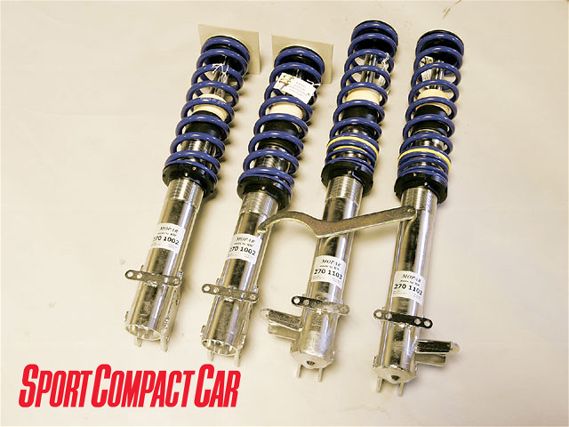 | Project Dodge SRT-4 - Tech Project
| Project Dodge SRT-4 - Tech Project
We have yet to try any real driving on the NeoGens since every spare second was spent leaving ribbons of rubber from the tire shop to the photo location. However, when we do get around to busting some curves on the new rubber, we'll let you know what we think.
Achieving the proper stance is vital in the looks of any musclecar. Doing so in this case meant getting rid of the SRT-4's ass-in-the-air stock ride height. However, doing this while still retaining proper handling balance is a must. We figured the Mopar boys probably knew the best way handle this situation, so we installed a Mopar coil-over kit, which is built by KW Suspension. The details of the installation, as well as handling testing will be included in the next installment. Until then, let it be said that the SRT-4's looks alone are much improved by the suspension-not to mention the smoke from its Nittos.

